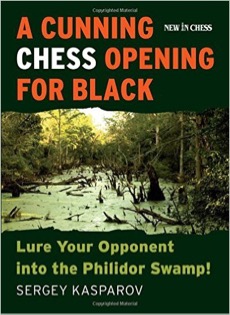Cunning Chess Opening for Black, A
Lure Your Opponent into the Philidor Swamp!
Sergey Kasparov

Sergey Kasparovs A CUNNING CHESS OPENING FOR BLACK is one stop shopping for those looking for an answer to 1.e4. Everything the reader needs to meet 1.e4 will be found in this volume.
The move-order difficulties of the old Philidor (1.e4 e5 2.Nf3 d6 3.d4 Nf6 4.dxe5 Nxe4 5.Qd5 or 3 Nd7 4.Bc4 c6 5.0-0 Be7 6.dxe5 dxe5 7.Ng5 Bxg5 8.Qh5 with the better ending) have led to a modern preference for 1.e4 d6 2.d4 Nf6 3.Nc3 e5. The price Black pays is allowing White the chance to head straight for an ending with 4.dxe5 dxe5 5.Qxd8+ Kxd8. Kasparov (born in Baku just like Garry Kimovich!) doesnt believe this ending offers White much and while it might be boring for some it does have the practical advantage that the second player doesnt have to learn all matter of double king pawn openings (Kings Gambit, Bishops Opening, Vienna Opening, Danish Gambit, Center Game etc.).
A CUNNING CHESS OPENING FOR BLACK: LURE YOUR OPPONENT INTO THE PHILIDOR SWAMP! uses model games to present its subject matter rather than the standard layout that is the norm for opening books. This enables Kasparov to devote more time to explaining the middle game strategy for both sides and indeed this book has much more explanatory prose than the typical opening treatise. While this makes this work more user friendly for players below 2300, those rated higher might be disappointed in the lack of a more structured approach despite the detailed opening index.
This volume covers the entire Philidor battleground starting with early attempts to steamroll the opening with Shirovs 5.g4 and an early Ng5/Bxf7+. Kasparov shows Blacks resources are up to the task. He also gives a good idea of the flexibility the second player enjoys in the main line after 1.e4 d6 2.d4 Nf6 3.Nc3 e5 4.Nf3 Nbd7 5.Bc4 Be7 6.0-0 0-0 where Black can choose between the classical plan of holding the strong point on e5 or trading on d4 which sometimes works out very well. The traditional 7.Re1 c6 is given a major look as is the newer 7 …a6 which yielded an easy draw to the Georgian Philidor specialist Mchedlishvili in his game with Peter Svidler in the 2012/2013 Bundesliga after 8.a4 b6 9.Ne2 Bb7 10.Ng3 Nxe4!? 11.Nxe4 d5 12.Bxd5 Bxd5 13.dxe5 Nxe5! 14.Nxe5 Bxe4 15.Qxd8 Raxd8 16.Bf4 f5?! (16 Ba8 17.a5 b5 18.Nc6 Bd6 was more precise according to Kasparov). 17.Nc6! Bxc6 18.Rxe7 Rf7 19.Rxc7 Rxc7 20.Bxc7 Rd2 21. Rc1 Be4 22.Bxb6 Bxc2 23.a5 Rxd1+ 24.Rxd1 draw. Even the new and quite successful 1.e4 d6 2.d4 Nf6 3.Nc3 e5 4.Nc3 Nbd7 5.Bc4 Be7 6.Be2 Nb6 is covered.
The latter is proving a hard nut to track to crack which explains why Parimarjan Negi in his book 1.e4 vs. The French, Caro-Kann and Philidor (Quality Chess 2014) proposes that White play 6.a4 before casting which renders the Nb6 dubious as Whites bishop can now retreat to the more active square a2 instead of e2 (without a4 in retreating to b3 leaves the bishop exposed to exd4 followed by …c5-c4).
After 6 …0-0 7.0-0 a6 another idea behind 6.a4 is revealed namely 8.a5 cutting across the plan of … b6 and …Bb7. If Black persists with his plan with 8 …b5 White has 9.axb6 cxb6 10.Qe2 and the fractured pawn structure promises White a considerable advantage Negi.
The Indian Grandmaster also has his own twist on the main line. He believes that after 7 c6 White should dispense with the immediate 8.Re1 and instead substitute the more flexible 8.h3!? as in some concrete lines the rook will go to d1. Concretely he believes Black is fine after 8… exd4 9.Nxd4 Ne5 whereas after 8.h3!? exd4 White has the simple 9.Qxd4. The difference between the lines can be seen in the line 8.Re1 exd4 9.Qxd4 Ne5! 10.Nxe5 dxe5 11.Qxe5 Ng4! planning …Bd6 with a strong initiative. Negi goes on to analyze Black 8th moves alternatives including 8 …Nxe4 9.Nxe4 d5 which he advocates meeting with the shocking reply 10.Re1!?
Negis book, which came out in late 2014, is missing in the bibliography to A CUNNING CHESS OPENING FOR BLACK: LURE YOUR OPPONENT INTO THE PHILIDOR SWAMP! and almost certainly was not available when Kasparov wrote his work. Much of Negis work is original and it would have been all but impossible for another author to anticipate it. While the Indian Grandmasters analysis needs practical tests it would be prudent for anyone planning to play the Philidor rated over 2000 to be aware of it and have done some homework on how to answer it.
Kasparovs book concludes with 35 exercises with detailed solutions testing the readers knowledge of typical Philidor plans. Player and opening indexes follow.
A CUNNING CHESS OPENING FOR BLACK: LURE YOUR OPPONENT INTO THE PHILIDOR SWAMP! is aimed chiefly at players rated 1800-2300 who will benefit from the many well-annotated games in this volume.
